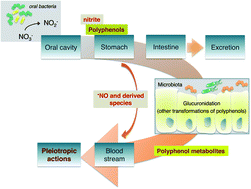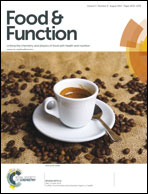A shortcut to wide-ranging biological actions of dietary polyphenols: modulation of the nitrate–nitrite–nitric oxide pathway in the gut
Abstract
Dietary polyphenols are complex, natural compounds with recognized health benefits. Initially attractive to the biomedical area due to their in vitro antioxidant properties, the biological implications of polyphenols are now known to be far from their acute ability to scavenge free radicals but rather to modulate redox signaling pathways. Actually, it is now recognized that dietary polyphenols are extensively metabolized in vivo and that the chemical, biophysical and biological properties of their metabolites are, in most cases, quite different from the ones of the parent molecules. Hence, the study of the metabolic, absorptive and signaling pathways of both phenolics and derivatives has become a major issue. In this paper we propose a short-cut for the systemic effects of polyphenols in connection with nitric oxide (˙NO) biology. This free radical is a ubiquitous signaling molecule with pivotal functions in vivo. It is produced through an enzymatic pathway and also through the reduction of dietary nitrate and nitrite in the human stomach. At acidic gastric pH, dietary polyphenols, in the form they are conveyed in foods and at high concentration, not only promote nitrite reduction to ˙NO but also embark in a complex network of chemical reactions to produce higher nitrogen oxides with signaling functions, namely by inducing post-translational modifications. Modified endogenous molecules, such as nitrated proteins and lipids, acquire important physiological functions. Thus, local and systemic effects of ˙NO such as modulation of vascular tone, mucus production in the gut and protection against ischemia–reperfusion injury are, in this sense, triggered by dietary polyphenols. Evidence to support the signaling and biological effects of polyphenols by modulation of the nitrate–nitrite–NO pathway will be herein provided and discussed. General actions of polyphenols encompassing absorption and metabolism in the intestine/liver are short-cut via the production of diffusible species in the stomach that have not only a local but also a general impact.

- This article is part of the themed collection: VI International Conference on Polyphenols and Health

 Please wait while we load your content...
Please wait while we load your content...